Check out our range of stock.
Didn't find what you like?
Send us a message
Found something out of stock?
Send us a message
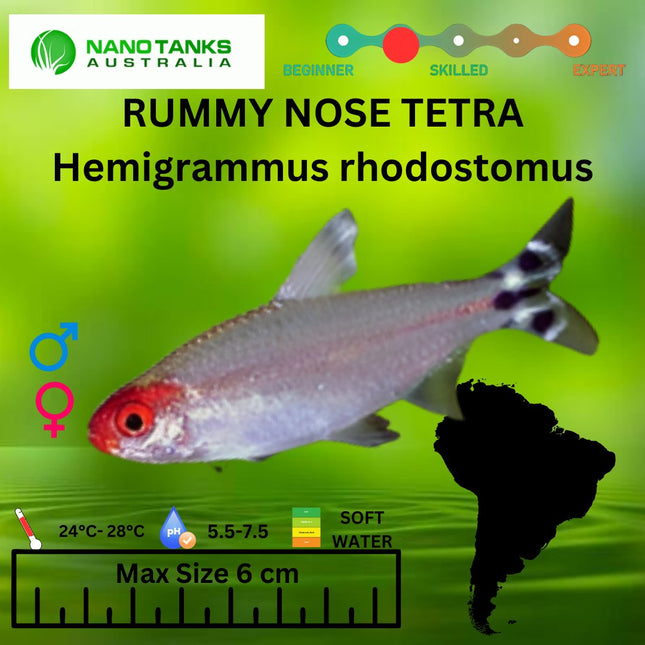
Category Rating Care Level: Moderate Temperament: Peaceful Color Form: Silver body, red nose, black/white striped caudal fin Lifespan: 6-8 years Size: 2-2.5 inches Diet: Omnivore Family: Characidae Minimum Tank Size: 20 gallons Tank Set-Up: Planted freshwater tank with open swimming space Compatibility: Peaceful community aquariums
$6.00
![[ARRIVED 24 - JUL - 2025] 4BT12 - Marble Fancy Halfmoon Plakat Male Betta - Nano Tanks Australia](http://nanotanksaustralia.com.au/cdn/shop/files/arrived-24-jul-2025-4bt12-marble-fancy-halfmoon-plakat-male-betta-1246880.jpg?v=1753353572&width=645)
Discover this rare betta fish for sale in Australia, exactly as shown in the photos. Each fish is healthy, vibrant, and full of personality—making it the perfect addition to your aquarium. Shipped safely from Sydney, our bettas are ready to thrive in your home tank. Specifications: Males: Approx. 4–5 cm | Giant bettas: 7–9 cm Females: Approx. 3–4 cm | Giant bettas: 7–9 cm Age: 3–6 months Origin: Imported from Indonesia or Thailand Important Notes: Koi, grizzle, and fancy bettas may naturally change colour and pattern as they grow or during transit. Long-fin varieties may occasionally nip their own tails—this is a natural behaviour. All fish are kept in Sydney tap water (23–26°C, pH ~7) to ensure they’re well-adjusted and healthy. Shipping: We ship live bettas from Sydney every Monday and Tuesday for the safest transit. Please see our Shipping Policy for more details. Optional Video:Want a closer look at your betta before purchase? Order a video of your exact fish through the link provided.
$29.00
![[ARRIVED 24 - JUL - 2025] 4BT13 - Red Fancy Halfmoon Plakat Male Betta - Nano Tanks Australia](http://nanotanksaustralia.com.au/cdn/shop/files/arrived-24-jul-2025-4bt13-red-fancy-halfmoon-plakat-male-betta-6316894.jpg?v=1753353572&width=645)
Discover this rare betta fish for sale in Australia, exactly as shown in the photos. Each fish is healthy, vibrant, and full of personality—making it the perfect addition to your aquarium. Shipped safely from Sydney, our bettas are ready to thrive in your home tank. Specifications: Males: Approx. 4–5 cm | Giant bettas: 7–9 cm Females: Approx. 3–4 cm | Giant bettas: 7–9 cm Age: 3–6 months Origin: Imported from Indonesia or Thailand Important Notes: Koi, grizzle, and fancy bettas may naturally change colour and pattern as they grow or during transit. Long-fin varieties may occasionally nip their own tails—this is a natural behaviour. All fish are kept in Sydney tap water (23–26°C, pH ~7) to ensure they’re well-adjusted and healthy. Shipping: We ship live bettas from Sydney every Monday and Tuesday for the safest transit. Please see our Shipping Policy for more details. Optional Video:Want a closer look at your betta before purchase? Order a video of your exact fish through the link provided.
$59.00
![[ARRIVED 24 - JUL - 2025] 4BT15 - Red Fancy Halfmoon Plakat Male Betta - Nano Tanks Australia](http://nanotanksaustralia.com.au/cdn/shop/files/arrived-24-jul-2025-4bt15-red-fancy-halfmoon-plakat-male-betta-8239636.jpg?v=1753353572&width=645)
Discover this rare betta fish for sale in Australia, exactly as shown in the photos. Each fish is healthy, vibrant, and full of personality—making it the perfect addition to your aquarium. Shipped safely from Sydney, our bettas are ready to thrive in your home tank. Specifications: Males: Approx. 4–5 cm | Giant bettas: 7–9 cm Females: Approx. 3–4 cm | Giant bettas: 7–9 cm Age: 3–6 months Origin: Imported from Indonesia or Thailand Important Notes: Koi, grizzle, and fancy bettas may naturally change colour and pattern as they grow or during transit. Long-fin varieties may occasionally nip their own tails—this is a natural behaviour. All fish are kept in Sydney tap water (23–26°C, pH ~7) to ensure they’re well-adjusted and healthy. Shipping: We ship live bettas from Sydney every Monday and Tuesday for the safest transit. Please see our Shipping Policy for more details. Optional Video:Want a closer look at your betta before purchase? Order a video of your exact fish through the link provided.
$59.00
![[ARRIVED 24 - JUL - 2025] 4BT21 - Red Fancy Halfmoon Plakat Male Betta - Nano Tanks Australia](http://nanotanksaustralia.com.au/cdn/shop/files/arrived-24-jul-2025-4bt21-red-fancy-halfmoon-plakat-male-betta-5559441.jpg?v=1753353572&width=645)
Discover this rare betta fish for sale in Australia, exactly as shown in the photos. Each fish is healthy, vibrant, and full of personality—making it the perfect addition to your aquarium. Shipped safely from Sydney, our bettas are ready to thrive in your home tank. Specifications: Males: Approx. 4–5 cm | Giant bettas: 7–9 cm Females: Approx. 3–4 cm | Giant bettas: 7–9 cm Age: 3–6 months Origin: Imported from Indonesia or Thailand Important Notes: Koi, grizzle, and fancy bettas may naturally change colour and pattern as they grow or during transit. Long-fin varieties may occasionally nip their own tails—this is a natural behaviour. All fish are kept in Sydney tap water (23–26°C, pH ~7) to ensure they’re well-adjusted and healthy. Shipping: We ship live bettas from Sydney every Monday and Tuesday for the safest transit. Please see our Shipping Policy for more details. Optional Video:Want a closer look at your betta before purchase? Order a video of your exact fish through the link provided.
$59.00
![[ARRIVED 24 - JUL - 2025] 4BT22 - Red Fancy Halfmoon Plakat Male Betta - Nano Tanks Australia](http://nanotanksaustralia.com.au/cdn/shop/files/arrived-24-jul-2025-4bt22-red-fancy-halfmoon-plakat-male-betta-3250191.jpg?v=1753353572&width=645)
Discover this rare betta fish for sale in Australia, exactly as shown in the photos. Each fish is healthy, vibrant, and full of personality—making it the perfect addition to your aquarium. Shipped safely from Sydney, our bettas are ready to thrive in your home tank. Specifications: Males: Approx. 4–5 cm | Giant bettas: 7–9 cm Females: Approx. 3–4 cm | Giant bettas: 7–9 cm Age: 3–6 months Origin: Imported from Indonesia or Thailand Important Notes: Koi, grizzle, and fancy bettas may naturally change colour and pattern as they grow or during transit. Long-fin varieties may occasionally nip their own tails—this is a natural behaviour. All fish are kept in Sydney tap water (23–26°C, pH ~7) to ensure they’re well-adjusted and healthy. Shipping: We ship live bettas from Sydney every Monday and Tuesday for the safest transit. Please see our Shipping Policy for more details. Optional Video:Want a closer look at your betta before purchase? Order a video of your exact fish through the link provided.
$59.00
![[ARRIVED 24 - JUL - 2025] 4BT25 - Red Fancy Halfmoon Plakat Male Betta - Nano Tanks Australia](http://nanotanksaustralia.com.au/cdn/shop/files/arrived-24-jul-2025-4bt25-red-fancy-halfmoon-plakat-male-betta-9820456.jpg?v=1753353572&width=645)
Discover this rare betta fish for sale in Australia, exactly as shown in the photos. Each fish is healthy, vibrant, and full of personality—making it the perfect addition to your aquarium. Shipped safely from Sydney, our bettas are ready to thrive in your home tank. Specifications: Males: Approx. 4–5 cm | Giant bettas: 7–9 cm Females: Approx. 3–4 cm | Giant bettas: 7–9 cm Age: 3–6 months Origin: Imported from Indonesia or Thailand Important Notes: Koi, grizzle, and fancy bettas may naturally change colour and pattern as they grow or during transit. Long-fin varieties may occasionally nip their own tails—this is a natural behaviour. All fish are kept in Sydney tap water (23–26°C, pH ~7) to ensure they’re well-adjusted and healthy. Shipping: We ship live bettas from Sydney every Monday and Tuesday for the safest transit. Please see our Shipping Policy for more details. Optional Video:Want a closer look at your betta before purchase? Order a video of your exact fish through the link provided.
$59.00

General care for shrimp: Temperature:18°-24°C Chlorine/chloramines: 0 ppm (very toxic for shrimp) Ammonia/Nitrite: 0 ppm. Nitrate: <20 ppm. pH: 6.2-7.5. GH: 4-8 dGH KH: 3-15 dKH Name Optimal TDS Limits Cherry shrimp 150 – 200 100 – 400 Cardinal shrimp 100 50 – 150 Tiger shrimp 180 – 220 100 – 300 We strongly recommend to drip acclimate any shrimp untill the TDS matches before you release the shrimp into your tank. Please note the above is just a general indication of the care requirements of shrimp. Results will vary depending on the individuals set up. NO SHIPPING TO WA
$20.00
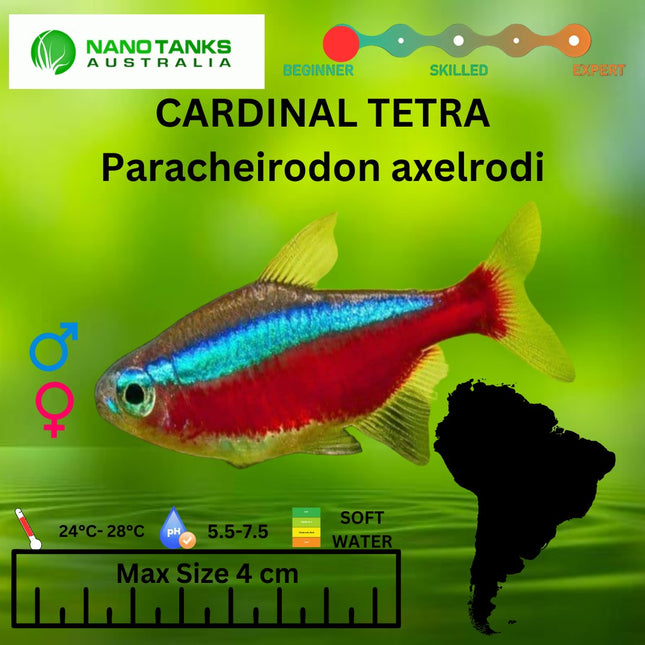
The Cardinal Tetra is a popular freshwater fish that many people enjoy keeping in their home aquariums. Cardinal tetras will quickly become one of the favourite fish in your aquarium. These tiny, schooling fish are hardy and playful—so much so that they can outsmart even seasoned aquarists! Cardinal tetra is a friendly fish that shares space generously with its tank mate. While they can be hard to breed in captivity, these brightly coloured fish stay active and are available in multiples colours of red, yellow, and orange. Habitat The cardinal tetra is most commonly seen in slow-moving, shallow water. They mainly eat small animals on plants roots and leaf litter but have been known to take live prey as well. The Cardinal Tetra (Paracheirodon axelrodi) is a fish that has been around for centuries. Originating from the rivers in South America, specifically the upper Orinoco and to the Rio Negro River. These little guys are fascinating because they usually only live about 2-3 years due to their small size but have still managed to thrive since then. Colour A Cardinal tetra is not only beautiful, but it's an excellent fish for almost any aquarium. Consider these benefits; they're small and sturdy enough that they can live in a 20-litre tank. They are tolerant of water quality fluctuations and the temperatures found in your home or office environment. Plus, they grow up to just 5cm long, so their accommodations will be easy as pie! And while we know you'll want to buy this beauty some friends once he gets settled in his new digs, don't worry about other types of fish bothering him—he'd rather eat plants than other aquatic life forms! Potential Tank mates for Cardinal Tetras Cardinal tetras are one of the most popular fish species. They should always be kept in large schools and prefer to swim around with others, even if they're not their kind! If you want your tank to have the perfect balance between lively company and a serene environment for some time alone, then these guys will become part of it. Potential tank mates that may be suitable other than tetras are Danios, Rasbora, and Dwarf Gouramis. If the companion fish has a big mouth enough to swallow the cardinal tetra, it is not a suitable tank mate. Cardinal Tetra Care There are a lot of reasons to purchase a larger aquarium. One of the most important is that Cardinal Tetras live better in bigger tanks! These fish can be seen living happily and healthily in tanks with 20 litres, but we always recommend going as big as you possibly can if you wish to enjoy the fish schooling to full effect. Cardinal Tetras are delicate and need mature tanks with soft acidic water to thrive. They can't survive in a tank that's only been set up for an hour, so use caution if you're new! Luckily they love having stable conditions because it lets them live longer lives without getting sick as often. The best pH is below 6, while the hardness should stay below 4 dGH (decigrams per litre) since high levels of minerals make their health deteriorate quickly. Finally, this species loves warmer temperatures but does well from 23°C to 27 °C. We recommend having Floating Plants on their tanks; not only do they moderate the light, but floating aquatic plants also help with CO2 and oxygen levels in the water. Diet and Feeding Cardinal Tetra will eat most foods, but be sure to feed them 75% of high-quality flake food, so they stay healthy! Make sure to provide live foods or frozen snacks for your little guys, including brine shrimp and bloodworms that are high in protein. If you're going to feed them all day, try offering three minutes' worth of food every feeding--their little mouths can't handle large pieces very well. Gender Identification Males and females show few apparent differences between the sexes, with female cardinal tetras having a deeper body than males with an almost round belly. The hook protruding from the male's anal fin tells other prospective mates they are mature enough to breed! Breeding Cardinal Tetras Breeding cardinal tetras is a difficult task. But if you are persistent, success will be within your grasp! The female cardinal tetra produces eggs when she feels the need to reproduce - typically during evenings and late nights from 130-500 eggs. A separate breeding tank with stable water conditions, a pH of 5.0 to 6.0, and very soft water 3-5 dGH or below is essential for success. FREQUENTLY ASKED QUESTIONS What is the Difference between Neon Tetra and Cardinal Tetra? The most obvious difference between the Cardinal and Neon Tetras is their coloration. While both are beautiful in their own right, it's hard to ignore that for Neons, only half of its body sports a vibrant red stripe while Cardinals have an equally colourful anal fin and gills as well as whole-body stripes. The main differences between these two fish types come down primarily to colouring: one has less than dazzling colours on about 50% of his body (Neon), where the other will stun you with brilliant blues, greens, yellows--even oranges! Of course, some structural distinctions like fins, but we are all more interested in how they look when swimming around our tanks anyway. Can a tetra live without a filter and heater? A tetra can live without a filter yes, a heater not so much. Below 24 degree's C your tetra will not be happy campers, however a regular water change can suffice in lieu of a filter.
$6.00
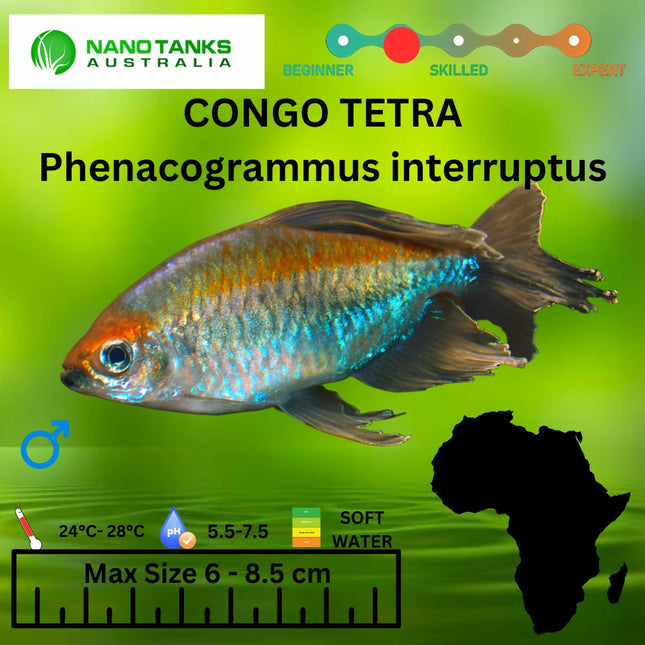
Classification Order: Characiformes Family: Alestidae Distribution: Wild populations are endemic to parts of the River Congo drainage in the Democratic Republic of Congo. Habitat: Most of the fish available in the trade are bred commercially in the Far East and Eastern Europe. Maximum Standard Length: Male 8cm. Female 6cm.The Congo Tetra (Phenacogrammus interruptus) is a very pretty fish that comes from the tributaries of the Congo River in Zaire. Preferring slightly acidic waters and murky waters they get to around 8 cm if given the time and the space to grow. They are very easy to keep and the males does grow these extraordinary long streamers that makes them absolutely divine in the tank. They prefer a temperature of around 26 to 30C and they prefer a pH of around 6.5 to 7.0. We have had Congo Tetras in our store for quite a long time and they have enjoyed being such a delightful staple within Nano Tanks Australia and OzDiscus. In fact they are so pretty that we put them in our display tanks. When you are looking for something that will go with Discus or Angelfish give Congo Tetras a go. They keep to themselves, they are easy to feed and easy to keep. Check out the Adult Congo Tetras that enjoys our tank. How to breed Congo Tetras Congo Tetras are egg scatterers. The best way to breed these is by breeding them in a group. For the average hobbyist however, Congo Tetras when they are old enough will naturally breed without much interference. How big do Congo Tetras get Congo Tetra Males get to around 12cm with Streamers on it's dorsal and Anal Fins, The Females get around 8cm and they won't have the streamers. Are Congo Tetras aggressive Congo Tetras are not aggressive but they should be kept in a school of greater than 6. The bigger the tank the better they will be. Are Congo Tetras fin nippers Congo Tetras are not fin nippers, however, they will eat whatever can fit into their mouths. They are the ideal companions for Discus and Angelfish and they won't touch any of these fish. Do Congo Tetra eat smaller fish They don't necessarily eat smaller fish. We have put guppies and other types of fish with Congo Tetras and they completely ignore them. However, if they do find something that is way too small and it's not as healthy they will eat any fish or any bigger fish. How long does it take for Congo Tetras to mature When given enough space 4ft or larger they will mature very quickly. When you buy them through the shop like ours they are usually 12 weeks old. They will be old enough within 12 months. Is my Congo Tetras dying Congo Tetras are tough fish! If you find that one is dying then it will not school with its tank mates then you will see that it will slowly die away. You will see that they will loose there colours when they are dying and you should remove fish when they are dying. What goes with Congo Tetras A lot of fish goes well with Congo Tetras, from South American Cichlids to Discus, to Angelfish and even Rainbowfish. They are truly a very nice fish to have in your tank. What is compatible with Congo Tetras They are best kept with South American Cichlids to Discus, to Angelfish and even Rainbowfish. What is the ideal kh for Congo Tetras kH is not required to be checked with Congo Tetras as it does not impact them. Will Congo Tetras eat cherry shrimp Congo Tetras will gobble up cherry shrimps no matter how small they are. So, please don't consider using Congo Tetras as tanks mates.
$15.00

Temperature: 72 to 79°F (22 to 26°C) pH: 6.4 to 7.4 Hardness: 2 to 15°H Each fish is 1.5cm Image from https://en.wikipedia.org/wiki/Pygmy_corydoras
$12.00
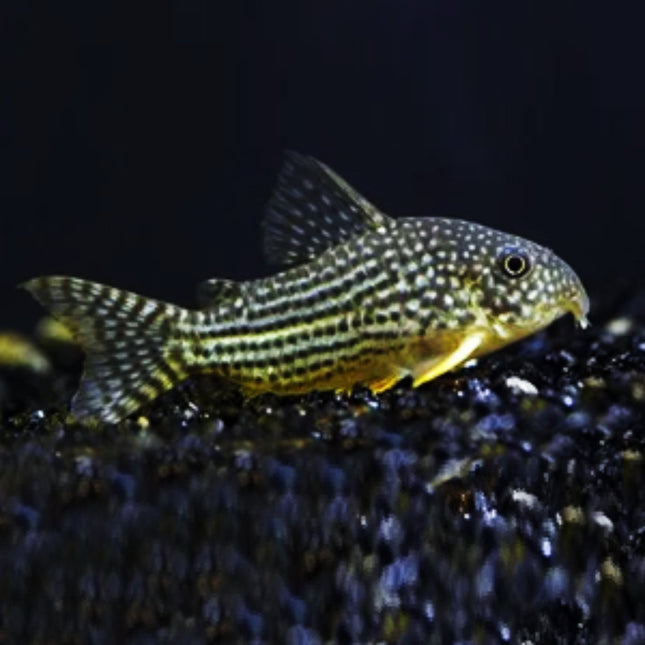
Corydoras sterbai is a small, peaceful fish that grows to a size of 3-3.5 cm (1.2-1.4 inches). It is native to South America, where it inhabits warm, slow-moving waters. This fish has a unique pattern of black, yellow, and white stripes and spots which makes it stand out in an aquarium. It is an active and peaceful fish that makes an excellent addition to a community tank, as it will get along well with other peaceful fish, such as tetras and small catfish. Corydoras sterbai is an omnivore, so it will eat a variety of prepared and live foods.
$15.00
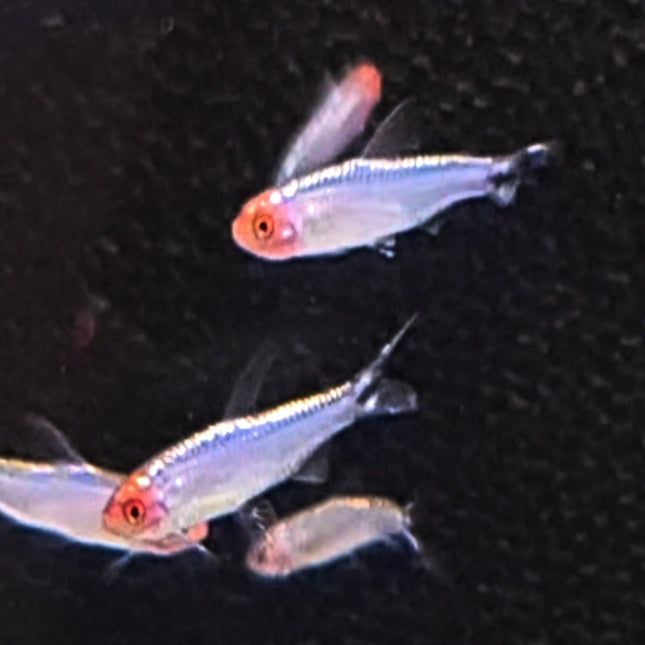
QUICK OVERVIEW: Category Rating Care Level: Moderate Temperament: Peaceful Color Form: Silver body, red nose, black/white striped caudal fin Lifespan: 6-8 years Size: 2-2.5 inches Diet: Omnivore Family: Characidae Minimum Tank Size: 20 gallons Tank Set-Up: Planted freshwater tank with open swimming space Compatibility: Peaceful community aquariums The Platinum Rummynose Tetra is a freshwater fish from the Characidae family native to South America. Three very similar species of fish are known as the rummy nose tetra: Hemigrammus rhodostomus (the true rummy nose tetra) Hemigrammus bleheri (also known as the brilliant rummy nose tetra or the common rummy nose tetra) Petitella georgiae (the false rummy nose tetra). The three species are native to South America, living in the Amazon River. Each species occupies a different region of the river. Shoaling fish are popular with beginners, but these are not the easiest to care for. These fish can be quite sensitive to water parameter changes, so you need to be vigilant. They don’t handle mistakes well. A group of rummy nose tetras works well in a community tank. This species is peaceful and gets along well with many other types of fish, but it won’t do well if kept with boisterous fish that cause it stress. They can live for 6-8 years in captivity if kept in a healthy environment. Typical Behavior These fish naturally gather in large groups, creating some impressive displays. The colors of the fish are more striking and their behaviors more impressive when they swim together. Platinum Rummynose Tetras tend to swim in the middle levels of the water, but they might stray up or down in order to feed. You might see them hiding among plants if they get stressed by bright lights or pestering fish. Platinum Rummynose Tetra Tank Mates You can keep Platinum Rummynose Tetras in groups of 6 or more. The schooling fish coordinate their movements and put on a nice little display. Other fish can be kept in the same tank with the Rummy Nose Tetra. The only things you need to worry about are keeping aggressive or large fish out of the tank. While a Platinum Rummynose Tetra will not bother other fish, its distinct markings make it a target for other bully fish. Here are some fish that make great tank mates for the Rummy Nose Tetra: Green Neon Tetra Pearl Gourami Corydoras Catfish Hatchetfish Yo-Yo Loach Cherry Barb Dwarf Gourami Harlequin Rasbora Appearance The Platinum Rummynose Tetra is popular because of its interesting colors and patterns across its body. The body of this fish is mostly silver with a deep red head giving it its name, while the caudal fin stands out just as much as the head with a zebra-like design of black and white horizontal stripes. The body is a torpedo shape with short, clear fins (except the caudal fin). When fully grown, this fish should reach 2.5 inches long. Food and Diet It’s easy to feed Platinum Rummynose Tetras. They are omnivores and thrive well on plant-based materials and protein. Generally, the fish will eat small bits of plant debris or algae. But you need to supplement those snacks with a regular balanced diet. Fish flakes and pellets work just fine. They should contain everything your Rummy Nose Tetra needs to stay healthy. Giving your fish a treat every once in a while is a nice way to keep them contented. Live or frozen foods such as daphnia, bloodworms and brine shrimp are favorites among most fish, and they provide protein too. Feed your fish two small meals a day, but don’t overfeed them: you don’t want excess food polluting the water chemistry. Watch how much food your fish are eating so you can adjust the amount accordingly. Breeding Platinum Rummynose Tetras are not difficult to breed; you simply must create optimal conditions in your tank to trigger spawning. The first step is ensuring that you have both males and females in the tank. Since it’s difficult to sex the fish, try purchasing multiple specimens and watching them for signs of courtship behavior. The temperature should be raised to 29 degrees Celcius, which mimics the warmer breeding season in the wild. If successful, the female will swim to a leaf and turn over so that the male can fertilize the eggs. She’ll then lay large eggs onto the leaf. At this point, remove all of the adult Rummy Nose Tetras; they are notorious for feeding on eggs and should be separated from breeding tanks. After about 24 hours, the eggs will hatch. The tiny fish fry will survive off of their egg sacs for up to 2 days. Then, they’ll be able to swim around the tank a bit. Provide them with some food that fry can eat. This includes specialized powder solutions, infusoria, or brine shrimp.
$8.00
![[LOCATED OFFSITE ARRIVED 23 - SEP - 2025] Red Laser Corydoras (Corydoras sp. CW014) 2 - 4cm - The Ultimate Collector's Cory - Nano Tanks Australia](http://nanotanksaustralia.com.au/cdn/shop/files/located-offsite-arrived-23-sep-2025-red-laser-corydoras-corydoras-sp-cw014-2-4cm-the-ultimate-collectors-cory-9846566.png?v=1758633594&width=645)
Experience the Brilliance of Red Laser Corydoras! Short Description:Behold the spectacular Red Laser Corydoras - one of the most vibrant and sought-after catfish in the aquarium world! Featuring an intense red-orange body accentuated by a bold black lateral stripe and metallic sheen, these stunning fish combine rare beauty with all the endearing personality Corydoras are known for. Key Features & Highlights 🔴 INTENSE RED-ORANGE COLOR: Vibrant, laser-red coloration that creates an stunning visual impact against dark substrates and green plants ⚫ BOLD CONTRAST STRIPE: Sharp, dark lateral stripe that perfectly accents the bright body color for maximum visual appeal ✨ METALLIC SHEEN: Captivating metallic glow that shimmers under aquarium lighting, making these fish truly sparkle 👨👩👧👦 SOCIAL SCHOOLING BEHAVIOR: Thrives in groups of 6+, displaying fascinating group dynamics and natural foraging behaviors 💎 COLLECTOR'S DREAM: A premium, highly desirable variety that represents the pinnacle of Corydoras breeding achievements Detailed Description Welcome to the elite world of Red Laser Corydoras! This exceptional variety represents years of selective breeding, resulting in a fish that seems to glow from within. The "laser" name is perfectly deserved - when a school of these crimson beauties moves across your aquarium, they create a breathtaking display of color and activity that's unmatched in the catfish world. What sets the Red Laser Corydoras apart is its remarkable combination of spectacular appearance and charming Corydoras personality. Despite their premium status, they display all the endearing behaviors that make these catfish so beloved - from their playful group dynamics to their constant substrate sifting. Watching a school of these vibrant fish work together is like observing living jewels in motion. These catfish are particularly stunning in planted aquariums where their intense red coloration creates dramatic contrast against green plants and dark substrates. Their peaceful nature and efficient cleaning habits make them both a visual centerpiece and a practical addition to any serious aquarist's collection. Perfect For: Planted display aquariums Serious Corydoras collectors Peaceful community tanks Aquarists seeking premium fish Breeding projects Specifications & Care Guide Parameter Requirement Scientific Name Corydoras sp. CW014 Common Names Red Laser Corydoras, Laser Cory Tank Size 20+ gallons for a school Temperature 72°F - 79°F (22°C - 26°C) pH Range 6.0-7.5 Water Hardness Soft to moderately hard (2-15 dGH) Adult Size 2-2.5 inches (5-6 cm) Diet Omnivorous - sinking pellets, wafers, frozen foods Lifespan 5-8 years with proper care Care & Feeding Tank Setup: Fine sand substrate essential for barbel protection Dark substrate recommended to enhance coloration Plenty of hiding spots and smooth decor Peaceful tank mates only Diet: High-quality sinking pellets and wafers Frozen and live foods (bloodworms, brine shrimp) Color-enhancing foods to maintain vibrancy Forages for leftover food and detritus Social Needs: Keep in groups of 6+ individuals Becomes more active and confident in schools Displays natural shoaling behaviors in proper groups Important Considerations ⚠️ GROUP REQUIREMENT: Must be kept in groups of 6+ for natural behavior and well-being 🚫 SENSITIVE BARBELS: Requires smooth sand substrate to prevent barbel damage and infection 🐠 PEACEFUL TANKMATES ONLY: Keep with other gentle, non-aggressive species 🌡 STABLE WATER CONDITIONS: Requires clean, well-maintained water parameters 💎 PREMIUM PRICING: Higher cost reflects rarity and selective breeding efforts 🔍 OBSERVATIONAL FISH: May be shy initially but become bold in established groups Live Arrival Guarantee Our Red Laser Corydoras are carefully acclimated and conditioned for shipping. Each order includes detailed care instructions and our live arrival guarantee ensures your premium fish arrive healthy and ready for their new home. Ready to add these living lasers to your aquarium? Bring home the spectacular Red Laser Corydoras today!
$150.00
![[ARRIVED 25 - JUL - 2025] 4BT31 - Red Fancy Halfmoon Plakat Male Betta *small* - Nano Tanks Australia](http://nanotanksaustralia.com.au/cdn/shop/files/arrived-25-jul-2025-4bt31-red-fancy-halfmoon-plakat-male-betta-small-9135945.jpg?v=1753440334&width=645)
Discover this rare betta fish for sale in Australia, exactly as shown in the photos. Each fish is healthy, vibrant, and full of personality—making it the perfect addition to your aquarium. Shipped safely from Sydney, our bettas are ready to thrive in your home tank. Specifications: Males: Approx. 4–5 cm | Giant bettas: 7–9 cm Females: Approx. 3–4 cm | Giant bettas: 7–9 cm Age: 3–6 months Origin: Imported from Indonesia or Thailand Important Notes: Koi, grizzle, and fancy bettas may naturally change colour and pattern as they grow or during transit. Long-fin varieties may occasionally nip their own tails—this is a natural behaviour. All fish are kept in Sydney tap water (23–26°C, pH ~7) to ensure they’re well-adjusted and healthy. Shipping: We ship live bettas from Sydney every Monday and Tuesday for the safest transit. Please see our Shipping Policy for more details. Optional Video:Want a closer look at your betta before purchase? Order a video of your exact fish through the link provided.
$20.00
![[ARRIVED 25 - JUL - 2025] 4BT34 - White Marble Halfmoon Plakat Male Betta - Nano Tanks Australia](http://nanotanksaustralia.com.au/cdn/shop/files/arrived-25-jul-2025-4bt34-white-marble-halfmoon-plakat-male-betta-4008291.jpg?v=1753440335&width=645)
Discover this rare betta fish for sale in Australia, exactly as shown in the photos. Each fish is healthy, vibrant, and full of personality—making it the perfect addition to your aquarium. Shipped safely from Sydney, our bettas are ready to thrive in your home tank. Specifications: Males: Approx. 4–5 cm | Giant bettas: 7–9 cm Females: Approx. 3–4 cm | Giant bettas: 7–9 cm Age: 3–6 months Origin: Imported from Indonesia or Thailand Important Notes: Koi, grizzle, and fancy bettas may naturally change colour and pattern as they grow or during transit. Long-fin varieties may occasionally nip their own tails—this is a natural behaviour. All fish are kept in Sydney tap water (23–26°C, pH ~7) to ensure they’re well-adjusted and healthy. Shipping: We ship live bettas from Sydney every Monday and Tuesday for the safest transit. Please see our Shipping Policy for more details. Optional Video:Want a closer look at your betta before purchase? Order a video of your exact fish through the link provided.
$15.00
![[ARRIVED 25 - JUL - 2025] 4BT35 - Red Fancy Halfmoon Plakat Male Betta - Nano Tanks Australia](http://nanotanksaustralia.com.au/cdn/shop/files/arrived-25-jul-2025-4bt35-red-fancy-halfmoon-plakat-male-betta-4462756.jpg?v=1753440334&width=645)
Discover this rare betta fish for sale in Australia, exactly as shown in the photos. Each fish is healthy, vibrant, and full of personality—making it the perfect addition to your aquarium. Shipped safely from Sydney, our bettas are ready to thrive in your home tank. Specifications: Males: Approx. 4–5 cm | Giant bettas: 7–9 cm Females: Approx. 3–4 cm | Giant bettas: 7–9 cm Age: 3–6 months Origin: Imported from Indonesia or Thailand Important Notes: Koi, grizzle, and fancy bettas may naturally change colour and pattern as they grow or during transit. Long-fin varieties may occasionally nip their own tails—this is a natural behaviour. All fish are kept in Sydney tap water (23–26°C, pH ~7) to ensure they’re well-adjusted and healthy. Shipping: We ship live bettas from Sydney every Monday and Tuesday for the safest transit. Please see our Shipping Policy for more details. Optional Video:Want a closer look at your betta before purchase? Order a video of your exact fish through the link provided.
$15.00
![[ARRIVED 25 - JUL - 2025] 4BT36 - White Marble Halfmoon Plakat Male Betta - Nano Tanks Australia](http://nanotanksaustralia.com.au/cdn/shop/files/arrived-25-jul-2025-4bt36-white-marble-halfmoon-plakat-male-betta-8531862.jpg?v=1753440334&width=645)
Discover this rare betta fish for sale in Australia, exactly as shown in the photos. Each fish is healthy, vibrant, and full of personality—making it the perfect addition to your aquarium. Shipped safely from Sydney, our bettas are ready to thrive in your home tank. Specifications: Males: Approx. 4–5 cm | Giant bettas: 7–9 cm Females: Approx. 3–4 cm | Giant bettas: 7–9 cm Age: 3–6 months Origin: Imported from Indonesia or Thailand Important Notes: Koi, grizzle, and fancy bettas may naturally change colour and pattern as they grow or during transit. Long-fin varieties may occasionally nip their own tails—this is a natural behaviour. All fish are kept in Sydney tap water (23–26°C, pH ~7) to ensure they’re well-adjusted and healthy. Shipping: We ship live bettas from Sydney every Monday and Tuesday for the safest transit. Please see our Shipping Policy for more details. Optional Video:Want a closer look at your betta before purchase? Order a video of your exact fish through the link provided.
$59.00
![[ARRIVED 25 - JUL - 2025] 4BT42 - Red Halfmoon Male Betta - Nano Tanks Australia](http://nanotanksaustralia.com.au/cdn/shop/files/arrived-25-jul-2025-4bt42-red-halfmoon-male-betta-3224000.jpg?v=1753440334&width=645)
Discover this rare betta fish for sale in Australia, exactly as shown in the photos. Each fish is healthy, vibrant, and full of personality—making it the perfect addition to your aquarium. Shipped safely from Sydney, our bettas are ready to thrive in your home tank. Specifications: Males: Approx. 4–5 cm | Giant bettas: 7–9 cm Females: Approx. 3–4 cm | Giant bettas: 7–9 cm Age: 3–6 months Origin: Imported from Indonesia or Thailand Important Notes: Koi, grizzle, and fancy bettas may naturally change colour and pattern as they grow or during transit. Long-fin varieties may occasionally nip their own tails—this is a natural behaviour. All fish are kept in Sydney tap water (23–26°C, pH ~7) to ensure they’re well-adjusted and healthy. Shipping: We ship live bettas from Sydney every Monday and Tuesday for the safest transit. Please see our Shipping Policy for more details. Optional Video:Want a closer look at your betta before purchase? Order a video of your exact fish through the link provided.
$38.00
![[ARRIVED 25 - JUL - 2025] 4BT45 - Red Fancy Halfmoon Plakat Male Betta - Nano Tanks Australia](http://nanotanksaustralia.com.au/cdn/shop/files/arrived-25-jul-2025-4bt45-red-fancy-halfmoon-plakat-male-betta-5681242.jpg?v=1753440334&width=645)
Discover this rare betta fish for sale in Australia, exactly as shown in the photos. Each fish is healthy, vibrant, and full of personality—making it the perfect addition to your aquarium. Shipped safely from Sydney, our bettas are ready to thrive in your home tank. Specifications: Males: Approx. 4–5 cm | Giant bettas: 7–9 cm Females: Approx. 3–4 cm | Giant bettas: 7–9 cm Age: 3–6 months Origin: Imported from Indonesia or Thailand Important Notes: Koi, grizzle, and fancy bettas may naturally change colour and pattern as they grow or during transit. Long-fin varieties may occasionally nip their own tails—this is a natural behaviour. All fish are kept in Sydney tap water (23–26°C, pH ~7) to ensure they’re well-adjusted and healthy. Shipping: We ship live bettas from Sydney every Monday and Tuesday for the safest transit. Please see our Shipping Policy for more details. Optional Video:Want a closer look at your betta before purchase? Order a video of your exact fish through the link provided.
$59.00
![[ARRIVED 25 - JUL - 2025] 4BT46 - Galaxy Koi Halfmoon Plakat Male Betta - Nano Tanks Australia](http://nanotanksaustralia.com.au/cdn/shop/files/arrived-25-jul-2025-4bt46-galaxy-koi-halfmoon-plakat-male-betta-8229136.jpg?v=1753440334&width=645)
Discover this rare betta fish for sale in Australia, exactly as shown in the photos. Each fish is healthy, vibrant, and full of personality—making it the perfect addition to your aquarium. Shipped safely from Sydney, our bettas are ready to thrive in your home tank. Specifications: Males: Approx. 4–5 cm | Giant bettas: 7–9 cm Females: Approx. 3–4 cm | Giant bettas: 7–9 cm Age: 3–6 months Origin: Imported from Indonesia or Thailand Important Notes: Koi, grizzle, and fancy bettas may naturally change colour and pattern as they grow or during transit. Long-fin varieties may occasionally nip their own tails—this is a natural behaviour. All fish are kept in Sydney tap water (23–26°C, pH ~7) to ensure they’re well-adjusted and healthy. Shipping: We ship live bettas from Sydney every Monday and Tuesday for the safest transit. Please see our Shipping Policy for more details. Optional Video:Want a closer look at your betta before purchase? Order a video of your exact fish through the link provided.
$59.00
![[ARRIVED 26 - MAR - 2025] Assorted Dwarf Gourami Males 4 - 6cm - Nano Tanks Australia](http://nanotanksaustralia.com.au/cdn/shop/files/arrived-26-mar-2025-assorted-dwarf-gourami-males-4-6cm-256192.png?v=1742988227&width=645)
The dwarf gourami is a peaceful and shy fish. If you have a pair of them, the two fish will swim together. Dwarf gouramis are considered labyrinth fish, which means they breathe the air with a lung-like labyrinth organ and need to have access to the water's surface. If you proceed to breed this species, their complex bubble nests display impressive construction instincts. Species Overview Common Names: Dwarf gourami, flame gourami, powder blue gourami, red gourami, sunset gourami Scientific Name: Trichogaster Ialius Adult Size: 2 inches Life Expectancy: 4–6 years Characteristics Family Belontiidae Origin India, West Bengal, Assam, and Bangladesh Social Peaceful Tank Level Top, mid-dweller Minimum Tank Size 5 gallons Diet Omnivore, will eat algae Breeding Egglayer, bubble nest Care Intermediate pH 6.0 to 7.5 Hardness 4 to 10 dGH Temperature 72 to 82 F (22 to 28 C) Origin and Distribution Originating in India, West Bengal, Assam, and Bangladesh, the dwarf gourami are native to thickly vegetated waters. They are often found together with other gourami species in the genus Trichogaster (also known as Colisa). In the river plains of northern India, larger species of gouramis are one of the most common food fish and are sold dried or as fish-meal in many markets. Colors and Markings Its common name "dwarf" fits this fish well, as it is one of the smallest of the gouramis. Males are slightly larger than females and have a bright orange-red body with turquoise-blue, vertical stripes that extend into the fins. Females remain a duller, silvery blue-gray color and never achieve the male's brilliant colors. Several color variants have been developed by selective breeding at fish farms, including solid light blue (powder blue), neon, rainbow, and red/blushing. Powder blues are predominately blue with only a little red showing on the body. Neons display a brighter blue pattern than the standard variety. Rainbows have especially brilliant orange-red bodies with blue stripes, in addition to a green-gold metallic sheen. Reds (flame gouramis) are almost solid red throughout the body with solid blue dorsal fins. Tankmates This species is usually peaceful and can be kept with other species that are not too large or aggressive. Other brightly colored species can sometimes cause male gouramis to become aggressive as they are mistaken for rivals. Peaceful, small schooling fish are suitable tank mates as well as most bottom-dwelling fish. Some potential tankmates may include dwarf cichlids, cardinal tetras, or neon tetras. Dwarf Gourami Habitat and Care Dwarf gouramis are well suited to smaller aquariums as well as community aquariums. Gouramis can be skittish when subjected to noise and should be kept in a quiet location. Provide plenty of vegetation, including floating plants that cover only part of the surface of the water, as these labyrinth fish need access to the surface of the aquarium to breathe air. Dwarf Gourami Diet and Feeding In nature, gouramis eat small insects and larvae from the surface of the water and graze on algal growth on rocks and plants. In captivity, they will eat flake food, freeze-dried food, frozen foods, and vegetable tablets. To maintain good health, supplement their diet with periodic feedings of live foods such as worms. Live foods should also be used to condition breeder pairs. Gender Differences Males are generally larger than females and more vividly colored. As males reach maturity, they develop elongated dorsal and anal fin tips that come to a point. In females, these fins are shorter and rounded. Breeding the Dwarf Gourami Lowering the water level to 6 to 8 inches and raising the water temperature to 82 degrees Fahrenheit will trigger spawning. Vegetation is essential as male gouramis construct bubble nests out of plant materials, which they then bind together with bubbles. Nests are very elaborate and sturdy, reaching several inches across and an inch deep. For aquarium plants, Limnophila aquatica, Riccia fluitans, Ceratopteris thalictroides, and Vesicularia dubyana are good choices for the breeding tank. You can also offer peat fiber as a building material. Once the nest has been built, the male will begin courting the female, usually in the afternoon or evening. He signals his intentions by swimming around the female with flared fins, attempting to draw her to the nest where he will continue his courting display. If the female accepts the male, she will begin swimming in circles with the male beneath the bubble nest. When she is ready to spawn, she touches the male on either the back or the tail with her mouth. Upon this signal the male will embrace the female, turning her first on her side and finally on her back. At this point, the female will release approximately five dozen clear eggs, which are immediately fertilized by the male. Most of the eggs will float up into the bubble nest. Eggs that stray are collected by the male and placed in the nest. Once all the eggs are secured in the nest, the pair will spawn again. If more than one female is present in the breeding tank, the male may spawn with all of them. The spawning sessions will continue for two to four hours and produce between 300 and 800 eggs. Upon completion, the male will place a fine layer of bubbles beneath the eggs, assuring that they remain in the bubble nest. At this point, the female(s) should be removed from the tank to reduce stress on the male. The male will then take sole responsibility for the eggs, aggressively defending the nest and surrounding territory. In 12 to 24 hours the fry will hatch and continue developing within the protection of the bubble nest. After three days they are sufficiently developed to be free-swimming. Remove the male from the tank once the fry have left the bubble nest, or he may consume the young. Feed the fry on micro-foods such as infusoria, rotifers, or commercial fry food for the first week. After a week, they can be fed freshly hatched brine shrimp and finely ground flake foods.
$15.00
![[ARRIVED 26 - MAR - 2025] Assorted Fantail 5 - 7cm - Nano Tanks Australia](http://nanotanksaustralia.com.au/cdn/shop/files/arrived-26-mar-2025-assorted-fantail-5-7cm-536172.jpg?v=1742987997&width=645)
Introducing the Assorted Fantail 5cm - a collection of vibrant and dynamic fish that thrive in coldwater environments. With its stunning colors and energetic nature, this fish will bring life to your aquatic space. Perfect for those seeking a unique and captivating addition to their home aquarium. Species Overview Common Names: Fantail goldfish, double tail goldfish Scientific Name: Carassius auratus Adult Size: 7 inches Life Expectancy: 10 to 15 years Characteristics Characteristics Family Cyprinidae Origin Asia Social Peaceful Tank Level Top, mid-dweller Minimum Tank Size 20 gallons Diet Omnivore Breeding Egg layer Care Easy pH 6.0 to 9.0 Hardness 6 to 12 dGH Temperature 55 to 80F (10 to 27 C)
$6.00

Assorted Guppies (Poecillia Reticulata) Our Assorted Guppies are locally bred, they are all mixed genetics and offer a range of colours. The General types that may be available are: Cobras Neon blue Japanese double sword Full Gold Dumbos And many other colours that doesn't fit our strict breeding schedule If you have a preference you can let us know in the notes and we will try our best.When buying Guppies we recommend either going all males or a ratio of 1 male to 2 females or more. this is to ensure the females are not getting too stressed out by the males who will constantly chase them wanting to breed. Temperature: 24 – 28°C pH: 6.5 – 7.8 Hardness: 8-12 dGH Lifespan: 2+ years Size: 3.5cm Diet: Omnivore Image from: aquaticarts
$7.00
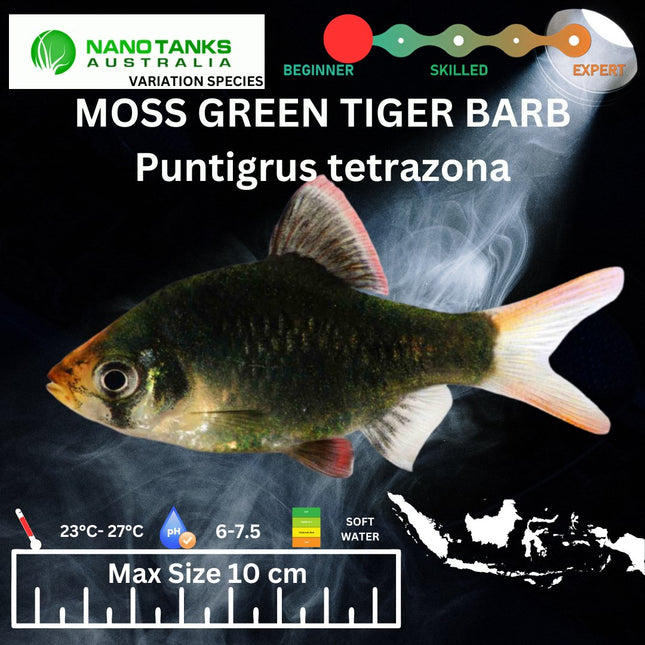
Appearance Tiger Barbs have an iconic look that even novice fish-keepers will instantly recognize. The body of the fish is quite wide. It’s tallest at the middle point and tapers down to a triangular-shaped snout. These fish are also quite colorful and have a very distinct pattern. The base color of Tiger Barbs is usually golden yellow. Some also have subtle rose gold tint. On top of that base color are several stripes. Care Tiger Barb care isn’t too difficult and can be handled by aquarists without much experience (assuming you stick to the recommendations in this guide). Otherwise, they wouldn’t be as widespread as they are! In general, these fish are relatively hardy and can adapt to simple setups as long as you cover the basics. That said, there are some aspects of their care that’ll require a bit of special attention. Despite their small size and beautiful looks, their strong personalities can be a handful! Here are the main care recommendations you need to know. Tank Size The minimum tank size for a small group of Tiger Barbs should be at least 20 gallons. However, we recommend going with a 30-gallon tank if you can. As we mentioned earlier, these fish are avid swimmers. The more room they have, the better. Plus, ample room to swim may help stave off aggressive behavior. Water Parameters In the wild, you can find Tiger Barbs inhabiting lakes, streams, and swamps that are lined with trees. Thanks to the decaying plant matter in the water, conditions tend to be more acidic. For the best results, you need to mimic their natural environment as closely as possible. That includes getting the water conditions just right. Luckily, the Tiger Barb can tolerate a generous range of conditions. As long as you stick within the following ranges, your fish should have no problem staying healthy. Water temperature: 68°F to 82°F degrees (aim for around 74°F if possible) pH levels: 6.0 to 8.0 (a slightly acidic 6.5 is best) Water hardness: 4 to 10 dKH To ensure that the aquarium has the proper water parameters you should invest in a reliable and accurate test kit. This will help you have confidence in the readings you’re getting, allowing you to make the right adjustments when necessary.
$9.00
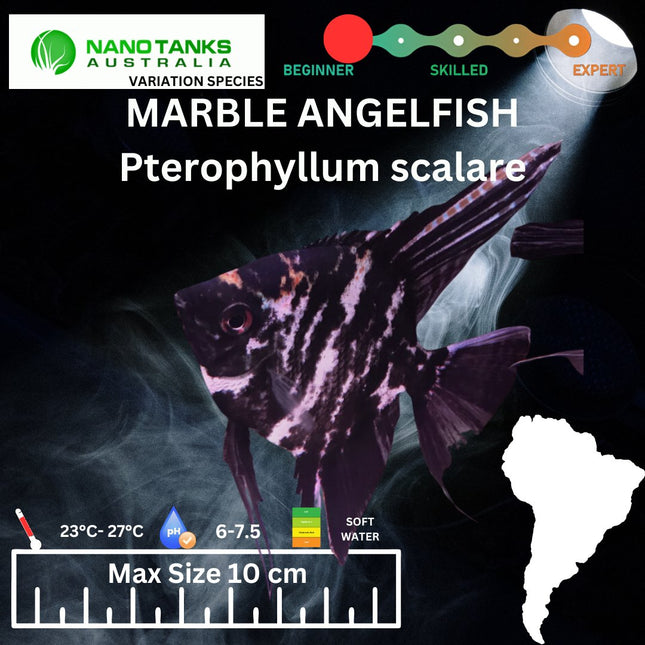
Discover the unique beauty of the Marble Angelfish. With its mesmerizing marble patterns, this fish is a stunning addition to any aquarium. Known for its docile nature, it is a peaceful fish that brings a sense of calm to any tank. Get ready to be captivated by this elegant species.
$15.00

These Smokey Angels are a variety of Pterophyllum scalare, which originated from the Amazon Basin, Orinoco Basin and various rivers in the Guiana Shield in tropical South America and are thus freshwater fish. Angelfish distinguish themselves from other cichlids in that they are strong laterally compressed, yet have a round body and elongated triangular dorsal and anal fins. These elegant yet strikingly shaped fish are popular with both beginner and experienced aquarists alike, and are a joy to observe. When buying Angels for breeding purposes, it is recommended to buy a group of 6 and let them pair off naturally. Once a pair is formed either move them to a breeding tank or sell off the others. Temperature: 24 – 28°C pH: 6.5 – 7.8 Lifespan: 10+ years Size: 10cm + Diet: Omnivore
$10.00
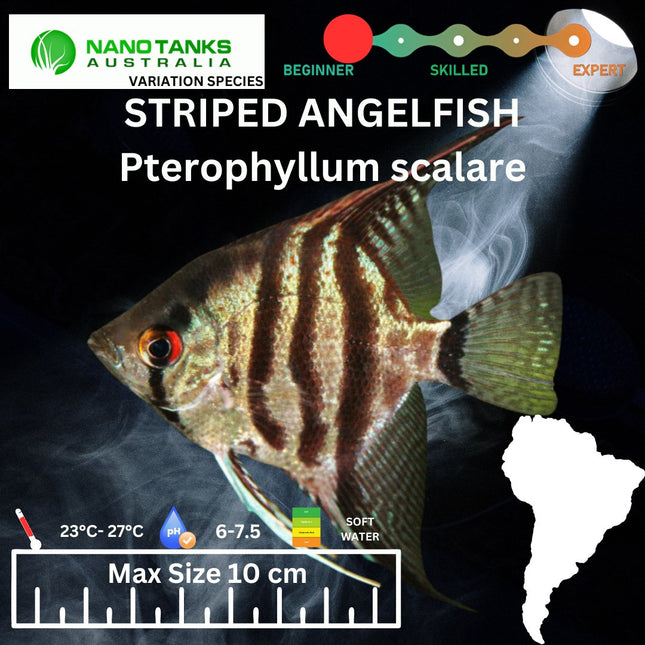
The Blue Sapphire Angelfish is a variety of Pterophyllum scalare, which originated from the Amazon Basin, Orinoco Basin and various rivers in the Guiana Shield in tropical South America and are thus freshwater fish. Angelfish distinguish themselves from other cichlids in that they are strong laterally compressed, yet have a round body and elongated triangular dorsal and anal fins. Sapphires grow to a moderate size, generally about 15cm long and can be kept in community tanks quite safely. These elegant yet strikingly shaped fish are popular with both beginner and experienced aquarists alike, and are a joy to observe. When buying Angels for breeding purposes, it is recommended to buy a group of 6 and let them pair off naturally. Once a pair is formed either move them to a breeding tank or sell off the others. Temperature: 24 – 28°C pH: 6.5 – 7.8 Lifespan: 10+ years Size: 10cm + Diet: Omnivore
$15.00
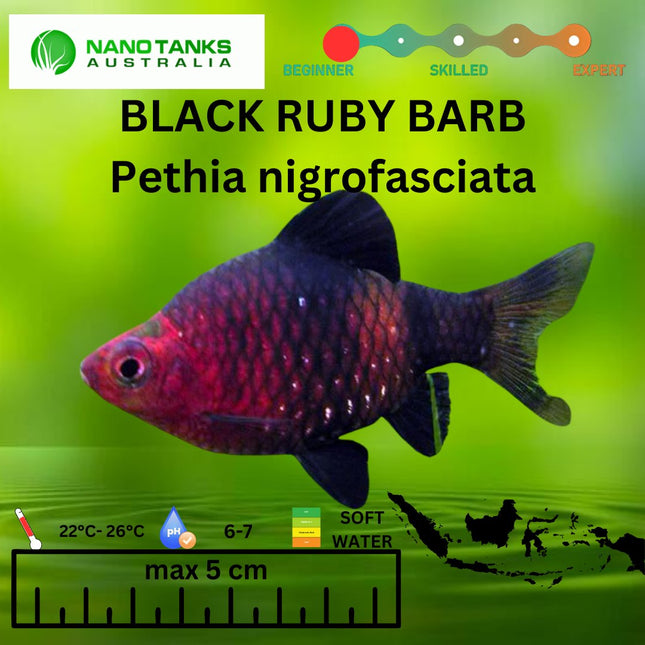
Please note the pictures depicts adult fish. Juvies are cream coloured with white stripes Origin and Distribution The ruby barb originates in Sri Lanka, where it was once plentiful in the forest streams in the upper elevations of the Kelani and Niwala river basins. This native habitat is composed of dense vegetation and slow-moving waters, which are colder than many tropical areas. The water in these streams is soft and acidic, and the river beds are composed of sand or fine gravel. Unfortunately, populations have greatly diminished due to over-catching by those selling these fish for export in the aquarium trade. Rapid deforestation has also eliminated much of the original habitat of these beautiful fish. At one point, they were on the brink of extinction but are currently listed as vulnerable by the International Union for Conservation of Nature (IUCN). Only with proper conservation methods will they remain as a viable population in the wild. As of 2020, the export of wild-caught ruby barbs from Sri Lanka is prohibited. All specimens sold in the aquarium trade are commercially bred, either in Sri Lanka or in a number of other countries that commercially breed aquarium fish. This commercial breeding has resulted in the creation of a variety of new colors and fin morphs compared with the wild fish. Colors and Markings Possessing a pointed head, high back, and deep body, the ruby barb is similar in body type to other banded barbs, such as the tiger barb. Three wide black bands run vertically through the body. In juvenile fish, the body is a pale yellow to yellow-gray. As the fish matures, the head becomes purple-red in color. In males, the entire body assumes this deep red color once they attain breeding age. Both sexes will pale in color when they are stressed, frightened, or are suffering from a disease or poor care. It is quite common for specimens in pet shops to appear washed out, then regain their bright coloration when taken to a quieter environment in a home aquarium. This species does not have barbels, which are feelers near the mouth or nasal cavity, like other barbs. Family Cyprinidae Origin Sri Lanka Social Peaceful Tank Level Bottom Minimum Tank Size 30 gallon Diet Filamentous algae and detritus Breeding Egg-scatterer Care Easy pH 6.0 to 6.5 Hardness 5 to 12 dGH Temperature 72 to 79 F (22 to 26 C)
$9.00
![[PREORDER 10 - APR - 2025] Gold Lace Glass Belly Short Body Guppy (Sold as pairs) - Nano Tanks Australia](http://nanotanksaustralia.com.au/cdn/shop/files/preorder-10-apr-2025-gold-lace-glass-belly-short-body-guppy-sold-as-pairs-943192.jpg?v=1744311715&width=645)
YELLOW LACE GLASS BELLY SHORT BODY IS CONSIDER NEW STRAIN THAT COMING TO GUPPY HOBBYIST MARKET. SMALL THAN OTHER GUPPY BUT THE SIZE AND THE UNIQUE MAKE IT MORE WANT BY THE GUPPY COLLECTORS.
$25.00 - $60.00

This is a variation of the Zebra Danio The Zebrafish (Danio rerio) is a freshwater fish belonging to the minnow family (Cyprinidae) of the order Cypriniformes. Native to South Asia, it is a popular aquarium fish, frequently sold under the trade name Zebra Danio (and thus often called a "tropical fish" although both tropical and subtropical). The Zebrafish is native to fresh water habitats in South Asia where it is found in India, Pakistan, Bangladesh, Nepal and Bhutan. The northern limit is in the South Himalayas, ranging from the Sutlej river basin in the Pakistan–India border region to the state of Arunachal Pradesh in northeast Indian. Its range is concentrated in the Ganges and Brahmaputra River basins, and the species was first described from Kosi River (lower Ganges basin) of India. Its range further south is more local, with scattered records from the Western and Eastern Ghats regions. It has frequently been said to occur in Myanmar (Burma), but this is entirely based on very old records (most recent from 1926) and likely refers to close relatives only described later, notably Danio kyathit. Likewise, old records from Sri Lanka are highly questionable and remain unconfirmed. The Zebrafish is named for the five uniform, pigmented, horizontal, blue stripes on the side of the body, which are reminiscent of a zebra's stripes, and which extend to the end of the caudal fin. Its shape is fusiform and laterally compressed, with its mouth directed upwards. The male is torpedo-shaped, with gold stripes between the blue stripes; the female has a larger, whitish belly and silver stripes instead of gold. Adult females exhibit a small genital papilla in front of the anal fin origin. The Zebrafish can reach up to 4–5 cm (1.6–2.0 in) in length, although they typically are 1.8–3.7 cm (0.7–1.5 in) in the wild with some variations depending on location. Its lifespan in captivity is around two to three years, although in ideal conditions, this may be extended to over five years. In the wild it is typically an annual species. Source: Wikipedia contributors. (2019, September 18). Zebrafish. In Wikipedia, The Free Encyclopedia. Retrieved 05:30, October 19, 2019, from https://en.wikipedia.org/w/index.php?title=Zebrafish&oldid=916415364
$8.00 $4.00

The Orca Aquarium Net Carbon Bag is a great way to add even more carbon filtration to your aquarium. This bag is designed to fit most small and medium-sized aquariums and comes with a convenient zipper closure. The small bag measures 6" x 9" and is perfect for smaller tanks. The bag is made of a strong and sturdy polyester material that is designed to trap and reduce odors and dissolved organics. The bag is also designed with a high-efficiency carbon-filtration system that will help keep your tank water clean and crystal clear. The bag can be easily hung over the side of the tank or placed inside to help keep your aquarium environment as healthy as possible.
$6.00
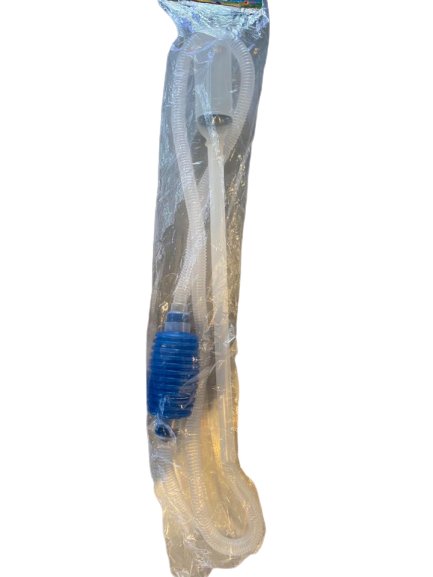
A hand-siphon is a device used to transfer liquids from one container to another. It consists of a flexible tube with one end inserted into the container holding the liquid and the other end in the new container. The tube is connected to a pump, which is operated by hand and uses suction to draw the liquid through the tube and into the new container. This can be used for tasks such as transferring fuel from a gas can to a lawn mower, filling a pool with water, or even emptying a fish tank. Hand-siphons are relatively inexpensive and easy to use, making them a useful tool for a variety of tasks.
$12.00

The Zebrafish (Danio rerio) is a freshwater fish belonging to the minnow family (Cyprinidae) of the order Cypriniformes. Native to South Asia, it is a popular aquarium fish, frequently sold under the trade name Zebra Danio (and thus often called a "tropical fish" although both tropical and subtropical). The Zebrafish is native to fresh water habitats in South Asia where it is found in India, Pakistan, Bangladesh, Nepal and Bhutan. The northern limit is in the South Himalayas, ranging from the Sutlej river basin in the Pakistan–India border region to the state of Arunachal Pradesh in northeast Indian. Its range is concentrated in the Ganges and Brahmaputra River basins, and the species was first described from Kosi River (lower Ganges basin) of India. Its range further south is more local, with scattered records from the Western and Eastern Ghats regions. It has frequently been said to occur in Myanmar (Burma), but this is entirely based on very old records (most recent from 1926) and likely refers to close relatives only described later, notably Danio kyathit. Likewise, old records from Sri Lanka are highly questionable and remain unconfirmed. The Zebrafish is named for the five uniform, pigmented, horizontal, blue stripes on the side of the body, which are reminiscent of a zebra's stripes, and which extend to the end of the caudal fin. Its shape is fusiform and laterally compressed, with its mouth directed upwards. The male is torpedo-shaped, with gold stripes between the blue stripes; the female has a larger, whitish belly and silver stripes instead of gold. Adult females exhibit a small genital papilla in front of the anal fin origin. The Zebrafish can reach up to 4–5 cm (1.6–2.0 in) in length, although they typically are 1.8–3.7 cm (0.7–1.5 in) in the wild with some variations depending on location. Its lifespan in captivity is around two to three years, although in ideal conditions, this may be extended to over five years. In the wild it is typically an annual species. Source: Wikipedia contributors. (2019, September 18). Zebrafish. In Wikipedia, The Free Encyclopedia. Retrieved 05:30, October 19, 2019, from https://en.wikipedia.org/w/index.php?title=Zebrafish&oldid=916415364
$8.00 $4.00
![Sunkist Cherry Shrimp 1 - 3cm 1 - 3cm [NO SHIPPING TO WA OR TAS] - Nano Tanks Australia Aquarium Shop](http://nanotanksaustralia.com.au/cdn/shop/files/sunkist-cherry-shrimp-1-3cm-1-3cm-no-shipping-to-wa-or-tas-154148.jpg?v=1738181824&width=645)
General care for shrimp: Temperature:18°-24°C Chlorine/chloramines: 0 ppm (very toxic for shrimp) Ammonia/Nitrite: 0 ppm. Nitrate: <20 ppm. pH: 6.2-7.5. GH: 4-8 dGH KH: 3-15 dKH Name Optimal TDS Limits Cherry shrimp 150 – 200 100 – 400 Cardinal shrimp 100 50 – 150 Tiger shrimp 180 – 220 100 – 300 We strongly recommend to drip acclimate any shrimp untill the TDS matches before you release the shrimp into your tank. Please note the above is just a general indication of the care requirements of shrimp. Results will vary depending on the individuals set up. Image by: Leah Cattarin NO SHIPPING TO WA
$12.00 $9.00
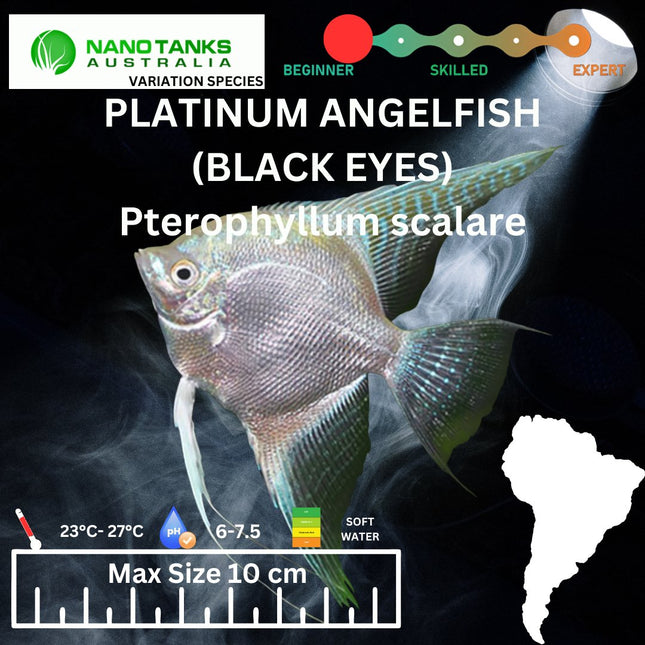
The Platinum Angelfish is a beautiful and unique freshwater fish that is native to South America. It has a deep, silvery body with a yellowish-white stripe down its back, and its fins are edged in bright white. Its tail is long and flows gracefully, giving it a veil-like appearance. It has a pointed nose and its eyes are a vibrant orange. It is a peaceful fish that is perfect for community aquariums and can get along with other species. It enjoys swimming in open areas and hiding in plants and decorations. It is an omnivore and requires a varied diet of both meaty and vegetative foods.
$15.00
You have seen 684 out of 933 products